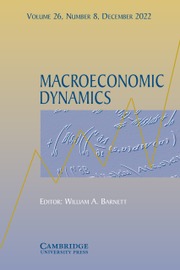No CrossRef data available.
Article contents
The green transition and public finances
Published online by Cambridge University Press: 27 October 2025
Abstract
This paper uses a dynamic general equilibrium approach that takes into account the macroeconomic implications of the green transition and its consequences for public finances. It shows that when the government relies too heavily on expenditure-based measures, it threatens the sustainability of public debt, by increasing the probability of sovereign default, leading to higher interest rates on government bonds. This higher public default risk has potentially significant repercussions on investment financing conditions for the private sector, and increases the cost of the transition to a net-zero economy. On the other hand, carbon pricing policies make the transition more viable for public finances, at the expenses of similarly high economic costs, while remaining effective in reducing greenhouse gas emissions. The welfare-maximizing optimal policy mix results in a balanced approach, with the public sector’s contribution to the total mitigation effort increasing gradually, ranging from 25% to 40% between 2030 and 2050.
Keywords
Information
- Type
- Articles
- Information
- Copyright
- © The Author(s), 2025. Published by Cambridge University Press

